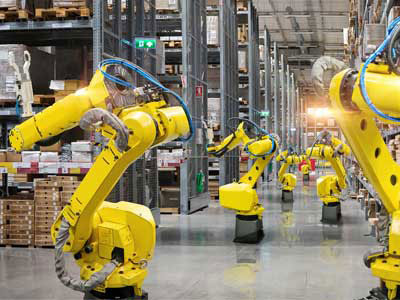Key Takeaway
Industrial robots offer several key advantages. They ensure consistent quality, as robots are programmed to deliver precise and repeatable results. This leads to fewer errors and higher product standards. Additionally, robots enhance productivity by operating continuously without breaks, significantly reducing cycle times. Safety is another crucial benefit; robots can handle hazardous tasks, minimizing the risk to human workers. Lastly, using robots can reduce labor costs by automating repetitive tasks, allowing human workers to focus on more complex and value-added activities. Overall, industrial robots improve efficiency, safety, and cost-effectiveness in manufacturing.
Operational Efficiency
Operational efficiency is crucial for maximizing productivity and profitability in industrial settings. It involves streamlining processes, optimizing resource utilization, and minimizing waste. At IndMALL, we focus on enhancing operational efficiency through innovative automation solutions and reliable industrial products. By integrating cutting-edge technologies like variable frequency drives (VFDs) and safety light curtains, we help businesses achieve smoother operations and higher output quality. Our commitment lies in providing tailored solutions that improve efficiency, reduce downtime, and ultimately drive business success in today’s competitive market landscape.

Precision and Accuracy
Precision and accuracy are the lifeblood of industrial robots, making them indispensable in modern manufacturing. These robots are engineered to perform tasks with exceptional repeatability, ensuring every product meets stringent quality standards. Imagine a production line in the electronics or automotive industry, where even the slightest deviation can lead to defects. Industrial robots eliminate these errors, consistently delivering products with exact measurements and intricate details. This high level of precision is particularly crucial in industries like aerospace, where safety and performance depend on flawless components.
Furthermore, the ability of robots to maintain such precision reduces the rate of defective products significantly. By automating tasks that require exactness, companies can uphold their quality standards effortlessly. This reliability translates to higher customer satisfaction and fewer returns or recalls, which can be costly and damaging to a brand’s reputation. Ultimately, the precision and accuracy of industrial robots ensure that manufacturers can produce high-quality products consistently, meeting and exceeding customer expectations.
Labor Cost Savings
One of the most compelling benefits of industrial robots is the potential for significant labor cost savings. While the initial investment in robotic systems can be hefty, the long-term financial benefits are substantial. Robots can take on repetitive, strenuous, and hazardous tasks, freeing human workers to focus on more complex, value-added activities. This shift not only optimizes the workforce but also reduces the dependency on manual labor, leading to considerable savings on labor costs over time.
Moreover, by minimizing the need for humans to perform dangerous tasks, robots help create a safer workplace. This reduction in workplace injuries lowers the associated costs, such as medical expenses and compensation claims. Additionally, a safer work environment boosts employee morale and productivity, as workers are more likely to feel secure and valued. In the long run, the savings on labor and the reduction in workplace accidents contribute to a more efficient and cost-effective operation, making the initial investment in robots worthwhile.
Flexibility in Manufacturing
Flexibility is a standout feature of modern industrial robots, allowing them to adapt to various production needs with ease. These robots can be reprogrammed to perform different tasks, making them ideal for industries that require versatility. For example, in a manufacturing plant that produces a wide range of products, robots can quickly switch between tasks, handling different items with minimal downtime. This adaptability means that manufacturers can respond swiftly to market changes and customer demands, without the need for significant retooling or delays.
Furthermore, the ability to customize operations to meet specific demands enhances the overall efficiency of the manufacturing process. Robots can be integrated into existing production lines and reconfigured as needed, ensuring that the production remains seamless and uninterrupted. This flexibility not only boosts productivity but also allows companies to stay competitive in a fast-paced market. By leveraging the versatility of industrial robots, manufacturers can maintain high levels of efficiency and quickly adapt to new challenges and opportunities.
Long-Term ROI
The long-term return on investment (ROI) of industrial robots is compelling and multifaceted. Despite the high upfront costs, the efficiency gains, labor savings, and consistent quality quickly justify the expenditure. Over time, these benefits contribute to a substantial ROI. For instance, robots can operate continuously without fatigue, leading to higher productivity and reduced downtime. This continuous operation ensures that production targets are met more consistently, contributing to increased revenue.
Additionally, robots can work in hazardous environments, reducing the risk of workplace accidents. This capability not only enhances safety but also lowers insurance costs and liability risks. By improving operational efficiency and reducing expenses related to human labor and safety, industrial robots offer a significant financial advantage. Companies can achieve a faster breakeven point and enjoy long-term savings, making the investment in robotics a strategic move for sustained growth and profitability.
Conclusion
Industrial robots offer numerous advantages in manufacturing and industrial applications. They enhance productivity through precise and repetitive tasks, improve quality with consistent output, and boost safety by handling hazardous operations. Robots also reduce operational costs by minimizing errors and downtime while optimizing resource utilization. Moreover, they enable flexibility in production, adapting quickly to varying demands. Overall, integrating industrial robots enhances efficiency, reliability, and competitiveness in modern industrial environments.
